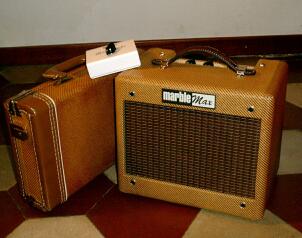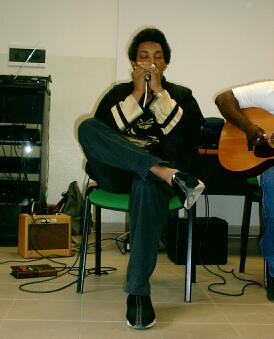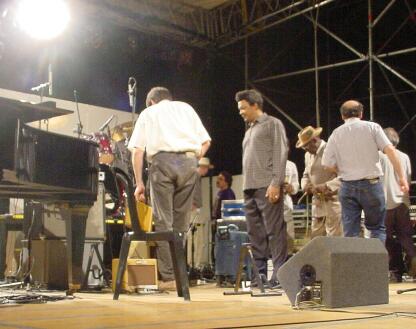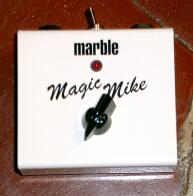The Marble Max Story
I was informed by my good friend Ben Bouman - the great harp player from Holland - about a hand-made and user friendly harp amp called the Marble Max. The amp is build by FNS a small Holland company following his suggestions. He had the opportunity to  test the first amp prototypes and he was completely satisfied with the end results. I own numerous amps, a 40' Silvertone, a 60' Supro, a customized Blues Junior, a mod Bassman, and many italians, and I have also built a couple, but - like many guitarists and harmonica players - I always need more. The Marble Max was reasonably priced and looked cool so I decided to give it a try. This year I was scheduled at the Castel S. Pietro Festival in an acoustic setting with my long-time buddy Roberto Menaḅ. I was excited because we had the opportunity to open to Sugar Blue and Pinetop Perkins Chicago Revue. The day before the festival, the parcel arrived. Inside
test the first amp prototypes and he was completely satisfied with the end results. I own numerous amps, a 40' Silvertone, a 60' Supro, a customized Blues Junior, a mod Bassman, and many italians, and I have also built a couple, but - like many guitarists and harmonica players - I always need more. The Marble Max was reasonably priced and looked cool so I decided to give it a try. This year I was scheduled at the Castel S. Pietro Festival in an acoustic setting with my long-time buddy Roberto Menaḅ. I was excited because we had the opportunity to open to Sugar Blue and Pinetop Perkins Chicago Revue. The day before the festival, the parcel arrived. Inside  I found the Marble Max and the Magic Mic box, a small op based device which optimise crystal mic impedance to the amp input side. No time to test the equipment but I trusted; so next morning we left Bologna and got Castel S. Pietro. And now some impressions and specifications on the amp itself:
I found the Marble Max and the Magic Mic box, a small op based device which optimise crystal mic impedance to the amp input side. No time to test the equipment but I trusted; so next morning we left Bologna and got Castel S. Pietro. And now some impressions and specifications on the amp itself:  aesthetically the Marble Max is a cool amp; it has the Champ size (look the picture above and compare its dimensions with respect to my Fender harmonica bag), is covered with aged tweed and has an old style leather handle. The circuit is based on vintage Fender tweed champ with many mods to fit the harp tonal requirements; the circuit layering is old style with short wiring and point to point component solderings; caps are Ruby orange drop and carbon resistors are generously used. Every detail is top class. It has a special designed ceramic 8 inch Weber speaker in an open
aesthetically the Marble Max is a cool amp; it has the Champ size (look the picture above and compare its dimensions with respect to my Fender harmonica bag), is covered with aged tweed and has an old style leather handle. The circuit is based on vintage Fender tweed champ with many mods to fit the harp tonal requirements; the circuit layering is old style with short wiring and point to point component solderings; caps are Ruby orange drop and carbon resistors are generously used. Every detail is top class. It has a special designed ceramic 8 inch Weber speaker in an open  configuration. Since it is cathode biased it can accept both a 6V6 and a 6L6 power tube. The overall tube layering is EZ81 (rect.), 12AY7 (pre-amp), 6V6 (power) with an estimated output of 6 Watts. At Castel S. Pietro we joined Sugar Blue and Eddie Taylor Jr. for a Blues at School program. Sugar is a highly gifted harmonica player who is still waiting for the recognition he deserves. He is known for his trademark fast riffs but that morning he played to the bone in a Walter Horton nervous vein. He played with my new Marble Max and my personally customized crystal mic and his tone was big and straight. I thought it was his tone. After the show Sugar complimented with me for my equipments. In the evening, I and Roberto did the sound check; since we played in the
configuration. Since it is cathode biased it can accept both a 6V6 and a 6L6 power tube. The overall tube layering is EZ81 (rect.), 12AY7 (pre-amp), 6V6 (power) with an estimated output of 6 Watts. At Castel S. Pietro we joined Sugar Blue and Eddie Taylor Jr. for a Blues at School program. Sugar is a highly gifted harmonica player who is still waiting for the recognition he deserves. He is known for his trademark fast riffs but that morning he played to the bone in a Walter Horton nervous vein. He played with my new Marble Max and my personally customized crystal mic and his tone was big and straight. I thought it was his tone. After the show Sugar complimented with me for my equipments. In the evening, I and Roberto did the sound check; since we played in the  main square I used the Marble Max to shape my tone and to monitor myself on stage and then I amplified the signal throughout a clever line-out plug which is hidden back in the amp chassis; the line-out is transformer tapped so you can pick the compressed signal directly from the output amp stage; I had no experience with this setting but judging from seasoned harp players in the audience it worked smoothly. The Marble Max has two hand-chicken knobs, one for the master volume and the other one for shaping the tone; I used the following regulation: V=6 and T=4. That evening we
main square I used the Marble Max to shape my tone and to monitor myself on stage and then I amplified the signal throughout a clever line-out plug which is hidden back in the amp chassis; the line-out is transformer tapped so you can pick the compressed signal directly from the output amp stage; I had no experience with this setting but judging from seasoned harp players in the audience it worked smoothly. The Marble Max has two hand-chicken knobs, one for the master volume and the other one for shaping the tone; I used the following regulation: V=6 and T=4. That evening we  played a 70 minutes great and intense gig; most of my merits go to the great little beast; while playing I heard the tone which I have in mind: warm tube distorsion, creamy tone and defined harmonics, this latter characteristic was the biggest surprise; most of my tube amps distorts with a muddy tone; the Marble Max retains a clear definition which is truly inspiring. We left the stage to Sugar Blue with the awareness of having played at our best level. We received compliments from Sugar himself, the organization staff, and from many people in the audience. All the harp players who attended the gig asked for my stage settings; I addressed them to the little beast called Marble Max. Since then I played a small club gig and the Marble at V=7 was perfect - I played with a six element blues-rock band; this time I also used the Magic Mic box; as I said before it is an op based circuit which optimise crystal mic impedance; the result is that the sound and output of the element increase thus simulating the drive of a controlled reluctance element still retaining the punch of the crystal cartridge. The overall combination is truly nasty. Finally I had another gig in a public garden; once again no problem; this time I amplified the big, creamy tone through a Shure SM 57 with great results. Ops I forgot the feedback issue; guys with this setting you forget it !! Gianandrea Pasquinelli
played a 70 minutes great and intense gig; most of my merits go to the great little beast; while playing I heard the tone which I have in mind: warm tube distorsion, creamy tone and defined harmonics, this latter characteristic was the biggest surprise; most of my tube amps distorts with a muddy tone; the Marble Max retains a clear definition which is truly inspiring. We left the stage to Sugar Blue with the awareness of having played at our best level. We received compliments from Sugar himself, the organization staff, and from many people in the audience. All the harp players who attended the gig asked for my stage settings; I addressed them to the little beast called Marble Max. Since then I played a small club gig and the Marble at V=7 was perfect - I played with a six element blues-rock band; this time I also used the Magic Mic box; as I said before it is an op based circuit which optimise crystal mic impedance; the result is that the sound and output of the element increase thus simulating the drive of a controlled reluctance element still retaining the punch of the crystal cartridge. The overall combination is truly nasty. Finally I had another gig in a public garden; once again no problem; this time I amplified the big, creamy tone through a Shure SM 57 with great results. Ops I forgot the feedback issue; guys with this setting you forget it !! Gianandrea Pasquinelli
Created on ... june 20, 2002
 test the first amp prototypes and he was completely satisfied with the end results. I own numerous amps, a 40' Silvertone, a 60' Supro, a customized Blues Junior, a mod Bassman, and many italians, and I have also built a couple, but - like many guitarists and harmonica players - I always need more. The Marble Max was reasonably priced and looked cool so I decided to give it a try. This year I was scheduled at the Castel S. Pietro Festival in an acoustic setting with my long-time buddy Roberto Menaḅ. I was excited because we had the opportunity to open to Sugar Blue and Pinetop Perkins Chicago Revue. The day before the festival, the parcel arrived. Inside
test the first amp prototypes and he was completely satisfied with the end results. I own numerous amps, a 40' Silvertone, a 60' Supro, a customized Blues Junior, a mod Bassman, and many italians, and I have also built a couple, but - like many guitarists and harmonica players - I always need more. The Marble Max was reasonably priced and looked cool so I decided to give it a try. This year I was scheduled at the Castel S. Pietro Festival in an acoustic setting with my long-time buddy Roberto Menaḅ. I was excited because we had the opportunity to open to Sugar Blue and Pinetop Perkins Chicago Revue. The day before the festival, the parcel arrived. Inside  I found the Marble Max and the Magic Mic box, a small op based device which optimise crystal mic impedance to the amp input side. No time to test the equipment but I trusted; so next morning we left Bologna and got Castel S. Pietro. And now some impressions and specifications on the amp itself:
I found the Marble Max and the Magic Mic box, a small op based device which optimise crystal mic impedance to the amp input side. No time to test the equipment but I trusted; so next morning we left Bologna and got Castel S. Pietro. And now some impressions and specifications on the amp itself:  main square I used the Marble Max to shape my tone and to monitor myself on stage and then I amplified the signal throughout a clever line-out plug which is hidden back in the amp chassis; the line-out is transformer tapped so you can pick the compressed signal directly from the output amp stage; I had no experience with this setting but judging from seasoned harp players in the audience it worked smoothly. The Marble Max has two hand-chicken knobs, one for the master volume and the other one for shaping the tone; I used the following regulation: V=6 and T=4. That evening we
main square I used the Marble Max to shape my tone and to monitor myself on stage and then I amplified the signal throughout a clever line-out plug which is hidden back in the amp chassis; the line-out is transformer tapped so you can pick the compressed signal directly from the output amp stage; I had no experience with this setting but judging from seasoned harp players in the audience it worked smoothly. The Marble Max has two hand-chicken knobs, one for the master volume and the other one for shaping the tone; I used the following regulation: V=6 and T=4. That evening we  played a 70 minutes great and intense gig; most of my merits go to the great little beast; while playing I heard the tone which I have in mind: warm tube distorsion, creamy tone and defined harmonics, this latter characteristic was the biggest surprise; most of my tube amps distorts with a muddy tone; the Marble Max retains a clear definition which is truly inspiring. We left the stage to Sugar Blue with the awareness of having played at our best level. We received compliments from Sugar himself, the organization staff, and from many people in the audience. All the harp players who attended the gig asked for my stage settings; I addressed them to the little beast called Marble Max. Since then I played a small club gig and the Marble at V=7 was perfect - I played with a six element blues-rock band; this time I also used the Magic Mic box; as I said before it is an op based circuit which optimise crystal mic impedance; the result is that the sound and output of the element increase thus simulating the drive of a controlled reluctance element still retaining the punch of the crystal cartridge. The overall combination is truly nasty. Finally I had another gig in a public garden; once again no problem; this time I amplified the big, creamy tone through a Shure SM 57 with great results. Ops I forgot the feedback issue; guys with this setting you forget it !! Gianandrea Pasquinelli
played a 70 minutes great and intense gig; most of my merits go to the great little beast; while playing I heard the tone which I have in mind: warm tube distorsion, creamy tone and defined harmonics, this latter characteristic was the biggest surprise; most of my tube amps distorts with a muddy tone; the Marble Max retains a clear definition which is truly inspiring. We left the stage to Sugar Blue with the awareness of having played at our best level. We received compliments from Sugar himself, the organization staff, and from many people in the audience. All the harp players who attended the gig asked for my stage settings; I addressed them to the little beast called Marble Max. Since then I played a small club gig and the Marble at V=7 was perfect - I played with a six element blues-rock band; this time I also used the Magic Mic box; as I said before it is an op based circuit which optimise crystal mic impedance; the result is that the sound and output of the element increase thus simulating the drive of a controlled reluctance element still retaining the punch of the crystal cartridge. The overall combination is truly nasty. Finally I had another gig in a public garden; once again no problem; this time I amplified the big, creamy tone through a Shure SM 57 with great results. Ops I forgot the feedback issue; guys with this setting you forget it !! Gianandrea Pasquinelli